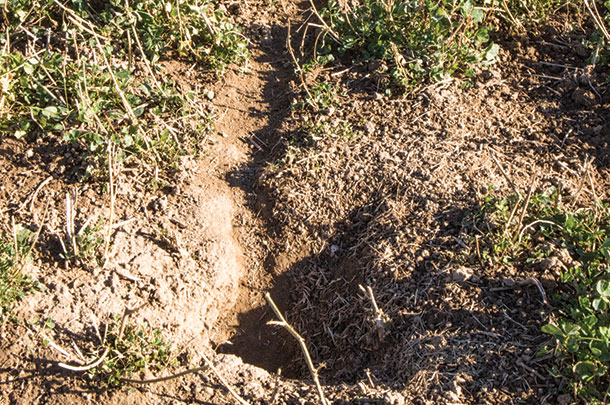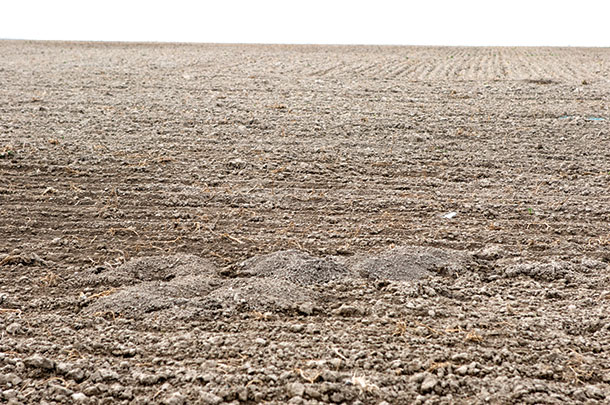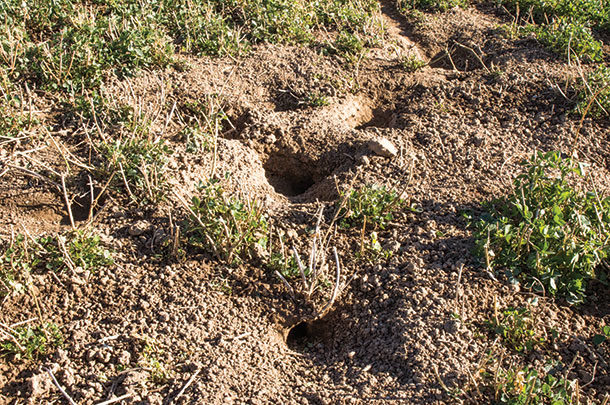They spend most of their time below ground, where they use their front legs and large incisors to create extensive burrow systems. Meadow voles are small, blunt-nosed, stocky rodents with small eyes and short ears and legs. They are typically dark grayish brown in color with size intermediate to that of a house mouse and a rat.
If left unchecked, pocket gophers and voles will cause extensive damage to alfalfa, with some studies estimating losses at 40 percent or more. This damage includes consumption of tap roots and above-ground vegetation that can result in reduced vigor or mortality of alfalfa plants, loss of irrigation water down burrow systems and chewing on subsurface drip lines.
Pocket gopher mounds can result in additional problems, including serving as weed seedbeds, burying of plants and causing damage to farm equipment.

A number of options are currently available for managing pocket gophers, but most management centers on toxic baits, fumigants and trapping. For voles, management in alfalfa centers on toxic baits and cultural practices.
Toxic baits
There are three primary toxic baits for pocket gopher management: 1) strychnine, 2) zinc phosphide and 3) anticoagulants (e.g., chlorophacinone and diphacinone). Both strychnine and zinc phosphide are considered acute toxicants; they kill after a single feeding. Strychnine has historically been the most effective toxicant for pocket gophers.
Zinc phosphide is also available for pocket gopher management, although poor bait acceptance can sometimes limit its efficacy. Anticoagulants are multiple feeding toxicants, so pocket gophers must consume these baits multiple times over the course of three to five days to receive a toxic dose. Recent laboratory trials have shown that strychnine products are far more efficacious than other rodenticides currently registered for pocket gopher management.
Subsequent field trials indicated 100 percent removal of pocket gopher populations across three study sites, so strychnine does still appear to be highly efficacious. However, pocket gophers often develop resistance to strychnine if repeatedly used over time. Therefore, strychnine should be used only as one part of an integrated pest management (IPM) program.
There are two primary methods for baiting in alfalfa fields: 1) hand baiting with an all-in-one probe and bait dispenser and 2) a burrow builder. Hand baiting provides more precise application of bait into burrow systems, but is more labor-intensive.
The experience of the individual who applies the bait is very important; those applicators who have been properly trained on how to use the equipment, and who can detect the difference between extant versus back-filled tunnels, are more than twice as efficacious as those individuals who have not received the proper training.

A burrow builder allows for more rapid bait application over larger areas. The burrow builder is a device that is pulled behind a tractor and creates an artificial burrow at a set depth. Bait is then deposited at set intervals along the artificial burrow.
Efficacy when using a burrow builder is greatly dependent upon setting the torpedo at the proper depth, frequent checks to ensure that bait is flowing properly and proper soil conditions to ensure the tunnels are constructed properly. As such, results when using a burrow builder are not as consistent as when applying bait via a hand probe.
For voles, the use of zinc phosphide is the primary management tool used in alfalfa, where it is applied directly to burrows and runways through spot treatments or broadcast applications. If overused, problems with bait shyness can occur. As such, zinc phosphide should not be applied more than twice per year. Additionally, zinc phosphide must be applied when new growth is less than 2 inches tall.
Zinc phosphide can off-gas when it comes into contact with water and should not be applied during heavy fog or when dew or precipitation are expected within the following 24 to 48 hours.
Fumigation
Aluminum phosphide is a highly effective tool for pocket gopher management, with efficacy generally in the range of 85 to 100 percent in treated burrow systems. The key with aluminum phosphide treatments is to only apply when soil moisture is relatively high. If you can ball up a clump of soil at the burrow depth and it maintains that ball in your hand, then soil moisture is high enough to fumigate; if the clump falls apart in your hand, it is too dry.
In addition to aluminum phosphide, carbon monoxide- generating machines can be used to manage pocket gophers. As their name implies, these devices generate carbon monoxide and inject it into the burrow systems, which then asphyxiates the inhabitants. Trials in northern California have indicated that this approach is moderately effective (56 to 68 percent), although less so than some other approaches.
Additionally, equipment can be expensive to purchase. However, many more burrow systems can be treated during a day with some of these machines (i.e., PERC, H&M Gopher Control), so these machines likely have utility moving forward, particularly for growers and pest control professionals who have large acreages to treat.
Fumigants are not typically used for vole control given the large amount of labor required to treat every burrow opening.
Trapping
Trapping is one of the most effective methods for managing pocket gophers. Counter to common perception, it can be a cost-effective management strategy when in friable soil types (excluding extremely sandy soils) or when soils are relatively moist. Of trap types tested, the Gophinator (Trapline Products) appears to be one of the most effective.
The increased effectiveness of the Gophinator is due to its ability to capture larger individuals at a greater rate. Various attractants have been tested to see if they might increase capture success; they generally do not. Human scent also does not influence capture success, so there appears to be little reason to worry about handling traps with bare hands.
Likewise, there does not appear to be a substantial difference in capture efficiency or capture rate when covering trap sets or leaving them uncovered. As such, using uncovered trap sets can save time and reduce cost of trapping programs.
Trapping is not typically used to manage vole populations. Voles can easily be captured with standard mouse snap-traps, but the amount of labor, time and resources required to remove voles from an alfalfa field is counterproductive.
Other management approaches
A variety of other options are sometimes used to manage pocket gophers and voles in alfalfa, including biocontrol, deep cultivation and flood irrigation. Biocontrol relies on natural predation to manage pocket gopher and vole populations. This typically involves the use of owl boxes to encourage predation of pocket gophers and voles.
Unfortunately, no replicated scientific study has shown that owls substantially reduce pocket gopher or vole populations in a field. Owls do eat a large number of rodents per year, but do so over a wide enough area that they may not be able to reduce pocket gopher or vole populations to low enough levels to constitute effective control. Further investigation is currently underway to identify if biocontrol has any real utility for managing burrowing rodents.
If an alfalfa field is going to be replanted, deep tillage will eliminate many burrow systems. Destroying the burrow systems helps slow down potential reinvasion into fields, and when combined with an aggressive pocket gopher and vole management program post-cultivation, it can provide a “clean slate” for a newly planted alfalfa field. Where still feasible, flood irrigation can also help manage pocket gopher and vole populations.
Importance of IPM
Although management options have primarily been discussed separately in this article, it is important to remember that an IPM approach that utilizes multiple techniques will generally provide best results. Reliance on any single approach allows rodents to develop behavioral or physiological avoidance mechanisms over time, thereby rendering those management tools less effective.
Lastly, it should be emphasized that for a management plan to be effective, continual effort must be exerted to eliminate established pocket gopher and vole populations. Once eliminated, continual effort must be exerted to remove reinvading rodents.
If pocket gopher and vole populations are allowed to reestablish, the whole removal cycle must be repeated, which is far more costly than frequent monitoring for, and removal of, reinvading rodents. Growers who devote the time and resources to regular rodent maintenance will see the greatest return on investment from these maintenance activities. ![]()
PHOTOS: By burrowing, voles and pocket gophers can reduce yields up to 40 percent. Feeding on tap roots and above-ground vegetation, creating irrigation water loss, chewing on SDI tape and creating ruts that damage farm equipment create havoc for farmers. Photos by Mike Dixon.

-
Roger A. Baldwin
- Cooperative Extension Specialist in human-wildlife conflict
- University of California – Davis
- Email Roger A. Baldwin








